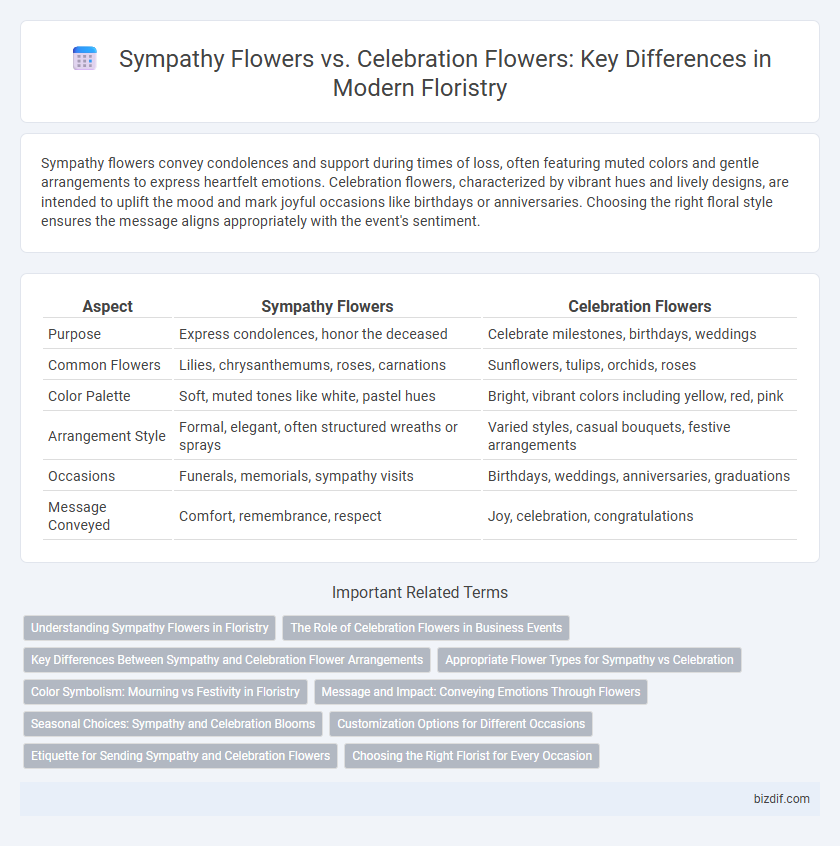Sympathy flowers convey condolences and support during times of loss, often featuring muted colors and gentle arrangements to express heartfelt emotions. Celebration flowers, characterized by vibrant hues and lively designs, are intended to uplift the mood and mark joyful occasions like birthdays or anniversaries. Choosing the right floral style ensures the message aligns appropriately with the event's sentiment.
Table of Comparison
| Aspect | Sympathy Flowers | Celebration Flowers |
|---|---|---|
| Purpose | Express condolences, honor the deceased | Celebrate milestones, birthdays, weddings |
| Common Flowers | Lilies, chrysanthemums, roses, carnations | Sunflowers, tulips, orchids, roses |
| Color Palette | Soft, muted tones like white, pastel hues | Bright, vibrant colors including yellow, red, pink |
| Arrangement Style | Formal, elegant, often structured wreaths or sprays | Varied styles, casual bouquets, festive arrangements |
| Occasions | Funerals, memorials, sympathy visits | Birthdays, weddings, anniversaries, graduations |
| Message Conveyed | Comfort, remembrance, respect | Joy, celebration, congratulations |
Understanding Sympathy Flowers in Floristry
Sympathy flowers in floristry are designed to convey condolences and offer comfort during times of grief, often featuring soft colors and serene arrangements such as lilies, chrysanthemums, and roses. These floral compositions emphasize sincerity and respect, reflecting cultural traditions associated with mourning and remembrance. Florists carefully select blooms that symbolize peace and remembrance to create meaningful tributes for funerals and memorial services.
The Role of Celebration Flowers in Business Events
Celebration flowers in business events enhance corporate atmospheres by symbolizing success, gratitude, and collaboration, making them essential for milestones such as product launches, anniversaries, and award ceremonies. Their vibrant colors and sophisticated arrangements contribute to positive client impressions and employee morale, reinforcing brand identity and corporate values. Unlike sympathy flowers, which convey condolences, celebration flowers serve to uplift and motivate participants, promoting a culture of achievement and recognition.
Key Differences Between Sympathy and Celebration Flower Arrangements
Sympathy flowers often feature muted tones like white lilies, roses, and chrysanthemums to convey condolences and solemnity, while celebration flowers utilize vibrant colors and mixed blooms such as sunflowers, daisies, and tulips to express joy and festivity. Arrangement styles for sympathy flowers are typically more structured and subdued, often designed as wreaths or sprays, whereas celebration flowers are arranged in dynamic, varied forms like bouquets or centerpieces to enhance the celebratory atmosphere. The emotional intent behind sympathy flower arrangements centers on comfort and remembrance, contrasting with celebration arrangements that focus on happiness and recognition of milestones.
Appropriate Flower Types for Sympathy vs Celebration
Sympathy flowers often include lilies, chrysanthemums, and roses in subdued colors like white, symbolizing peace and condolence, while celebration flowers feature bright, vibrant blooms such as sunflowers, tulips, and gerberas to convey joy and festivity. Choosing carnations and orchids can suit both sympathy and celebration, but the color palette and arrangement style differentiate their intended sentiment. For sympathy arrangements, soft pastels and muted tones are preferred, whereas bold, colorful bouquets are typical for celebrations like birthdays and anniversaries.
Color Symbolism: Mourning vs Festivity in Floristry
Sympathy flowers often feature muted tones like white, pale yellow, and soft pastels symbolizing peace, reverence, and condolence in mourning traditions. Celebration flowers burst with vibrant colors such as red, orange, and bright pink, representing joy, energy, and festivity. Understanding color symbolism helps florists select arrangements that appropriately express the intended emotional message, whether for grief or celebration.
Message and Impact: Conveying Emotions Through Flowers
Sympathy flowers convey condolences and support through soft colors and gentle arrangements, often incorporating lilies, chrysanthemums, and roses that symbolize peace and remembrance. Celebration flowers use vibrant hues and dynamic designs, featuring blooms like sunflowers, tulips, and daisies to express joy, excitement, and congratulations. The choice of flower type, color, and arrangement plays a crucial role in conveying the intended emotional impact, making floristry a powerful medium for communicating sentiments.
Seasonal Choices: Sympathy and Celebration Blooms
Sympathy flowers often feature seasonal blooms like chrysanthemums, lilies, and carnations, chosen for their traditional meanings of remembrance and comfort during difficult times. Celebration flowers tend to embrace vibrant seasonal varieties such as tulips, sunflowers, and peonies, symbolizing joy, success, and festivity. Selecting flowers aligned with the season ensures freshness and enhances the emotional impact of both sympathy and celebration arrangements.
Customization Options for Different Occasions
Sympathy flowers often feature subdued color palettes such as whites, greens, and soft pastels to convey respect and comfort, with popular arrangements including lilies, chrysanthemums, and roses customized through ribbon colors and personalized messages. Celebration flowers embrace vibrant hues and diverse blooms like sunflowers, orchids, and gerberas, offering customizable options in bouquet size, flower types, and arrangement styles to suit birthdays, anniversaries, or achievements. Both categories provide tailored floral designs that reflect the occasion's emotional tone while allowing personalization in packaging, card inscriptions, and flower combinations.
Etiquette for Sending Sympathy and Celebration Flowers
Sympathy flowers should be sent promptly after hearing of a loss, favoring muted colors and traditional arrangements like lilies or chrysanthemums to convey condolences respectfully. Celebration flowers, characterized by bright, vibrant blooms such as roses or gerbera daisies, are typically sent to mark joyful occasions and should reflect the recipient's personal taste or event theme. Proper etiquette dictates including a thoughtful, personalized note and considering the recipient's cultural or religious background to ensure the gesture is appropriate and well-received.
Choosing the Right Florist for Every Occasion
Choosing the right florist is crucial for both sympathy flowers and celebration flowers to ensure the arrangement conveys the appropriate emotions. Sympathy flowers often require a sensitive touch, with florists experienced in creating subdued, elegant designs that express condolences and support. Celebration flowers demand vibrant, joyful compositions crafted by florists skilled in selecting seasonal blooms and personalized arrangements that match the occasion's tone.
Sympathy Flowers vs Celebration Flowers Infographic

 bizdif.com
bizdif.com